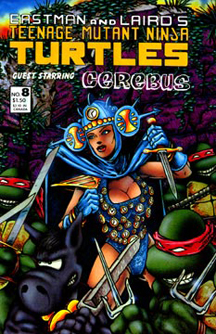After the meat-and-potatoes ninja action of Issue 1, Eastman and Laird went on a flurry of world building in Mirage “Teenage Mutant Ninja Turtles” Volume 1. Issues 4-7 showed us that the TMNT-verse spans to other planets, and Issues 8-9 (1986) add magic and mysticism to the fold.
While I somewhat resent the departure from the core concept, I also have to acknowledge that these other elements will allow “TMNT” to be a sprawling, long-running saga.
Eastman and Laird team up with Dave Sim
I loved the Triceraton/Fugitoid stuff as a kid because I was able to match up those adventures with my action figures. For the same reason, I didn’t like – or even understand – the Renet/Savanti Romero/Cerebus story in Issue 8; none of these characters made the cut as action figures or cartoon characters (although timestress Renet and Savanti, a villain of the time-hopping realm, would later appear in the 2003 TV series).

“Teenage Mutant Ninja Turtles” Issues 8-9 (1986)
Titles: “Team Up with Cerebus” (No. 8), “The Passing” (No. 9)
Writers: Kevin Eastman, Peter Laird, Dave Sim
Pencils: Kevin Eastman, Peter Laird, Michael Dooney
Inks: Kevin Eastman, Peter Laird, Dave Sim, Gerhard, Michael Dooney, Ryan Brown, Jim Lawson
I saw that Dave Sim was a co-writer, and because we’re thrown smack-dab into the middle of Renet’s feud with her boss, Lord Simultaneous, I assumed ALL the supporting characters were his and I needed to read “Cerebus the Aardvark” to understand it all.
In reality, the bitterly sarcastic Cerebus is Sim’s, but the others are new Mirage characters who will go on to play important parts whenever “TMNT” has the urge to do a time-hopping tale.
Renet is the put-upon and/or whiny human teenage apprentice to Lord Simultaneous in the “79th level of the dimension of null-time.” Using her magic time-travel scepter (which, unfortunately, would later inspire the writers of “TMNT III”), Renet pops into 1986 New York, then pops herself and the Turtles into 1406 feudal Europe; a battle with the evil goat-mutant Savanti Romero ensues, and it ends with the Turtles safe at home again, and Renet back in null-time, whining and dusting Simultaneous’ books.
Cerebus doesn’t really need to be in the story; his sarcasm – plus the way Sim’s drawings of the aardvark appear on panels otherwise done by E&L – seems intrusive. But it’s a fun and wild romp that I enjoyed a lot more on this reading; while I’m not crazy about Savanti and his clichéd thirst for powerful objects, I do like the bubbly Renet and the way even the teenage Turtles grow to be annoyed by her whining.
The Turtles befriend other outsiders
In these early Mirage issues, E&L take the Turtles to other planets and other times — and have them interact with robots, dinosaur-men and aardvarks, plus humans (April, Renet, Casey Jones) who aren’t fazed by the Turtles’ other-ness. (Renet is more wowed by the Big Apple than by meeting talking mutant turtles.)

This suggests to me that Eastman and Laird were bored right off the bat with the outsider theme; after all, “TMNT” was a parody of – among other things – “X-Men,” and E&L didn’t want to rip off anything too blatantly.
Also, all stories about weird realms that parallel everyday life eventually get to the point that it’s absurd to maintain that the general public doesn’t know what’s going on. “Buffy,” by the time of the Season 8 comic, made vampires an accepted part of society. More and more characters accepted the weirdness as “The X-Files” moved forward. “TMNT,” in Laird’s Volume 4, made mutants and alien brain invaders part of mainstream society.
In the early days, E&L wanted to give the Turtles playmates so they wouldn’t be so lonely. While the Turtles run from the cops in Issues 1 and 3, and are always vaguely worried about being discovered, E&L aren’t at all interested in the “Turtles revealed to society and persecuted for their otherness” cliché, and I think it’s to their credit as original, independent storytellers.
Plus, it’d be tiresome to have the Turtles repeat their origin story every time they meet someone new; the problem of necessitated exposition is the main reason why “Ghost Whisperer” is unwatchable: In every single episode, Jennifer Love Hewitt has to convince the guest character that she can speak to ghosts.
Pre-teen Turtles
On the other hand, the organic nature of indie-comic world-building has a potential downside when the creators change their minds about something.
The first example of this comes in the flashback story of Issue 9 (this inaugural issue to get an on-page title is called “The Passing”) when we see the pre-teen Turtles – at around age 12, I’m guessing – engage in a significant battle with ninjas. This puts the lie to Leo’s assertion that they had their “first major skirmish” in Issue 1.
At any rate, with space travel, time travel and magic checked off the list, Issue 9 adds mysticism: Traveling through dream-space, Splinter goes to Japan and agrees to switch bodies with an old man. Then “Splinter” leads the Turtles in killing some ninjas and settling a family feud between the noble old man and his criminal kingpin son.
Also notable in this issue, Splinter doesn’t allow Raph and Mike to use sais and nunchucks yet; this nicely illustrates how Splinter gradually worked them up to their remarkable level of ninja prowess by age 15.
So with the rules of the TMNT universe now in place, a reader might feel like it’s time to get back to the main Turtles vs. Foot Clan story. E&L were thinking the same thing, thankfully, and it’ll lead to some of the best issues Mirage ever produced …

